Running a small business is no easy task. It takes a lot of dedication to succeed.
But in the face of all the challenges, small businesses are an integral part of the economy.
According to recent reports, there are now more than 8 million small businesses in America. And they employ over 100 million people.
That’s nearly half of the American workforce! And those numbers are only going up.
Are you thinking about starting a new business? Or maybe you’re just curious about essential numbers and facts?
Learn how to recreate in-store experiences for your small business
Before we start analyzing the most important trends, let’s try to define what a small business actually is.
According to the criteria established by Small Business Administration, small businesses are mostly defined as businesses having less than 500 employees.
In addition, some types of companies cannot exceed revenue limits specified by North American Industry Classification System. For example, an office of real estate agents that earns more than $13 million doesn’t meet the small business criteria.
If you are still not sure whether your company can be classified as small, you can check the SBA’s table of small business size standards.

Now—
Let’s go through the most important facts about small businesses in more detail.
1. According to SBA, there are over 8 million small businesses in the US in 2022
And that’s only the number of employer businesses. If we count solo entrepreneurs and other non-employer establishments, that number goes up to over 30 million!
In the recent two decades, more and more people have decided to start their own business instead of working for someone else. And that is amazing news. Self-employment offers many advantages and opportunities that you simply cannot find in the traditional workforce.

Now—
Some would argue that 99.9% of all companies operating in the United States are small businesses. That’s because almost every business in America is considered a small business according to the SBA (U.S. Small Business Administration).
Why?
Most American businesses have less than 500 employees. And according to the official definition, you’re basically either a small business or an enterprise, and there’s nothing in between.
Therefore, it may be useful to take a closer look at the actual number of employees per business.
2. About 85% of established small businesses have fewer than 20 employees

While the definition of “small business” varies, the vast majority of businesses in US are indeed small. Over half of all companies operate with fewer than 5 people. These companies are usually started by a single person with some assistance from family and friends. They are typically owner-operated with the owner also serving as the primary salesperson.
Companies with fewer than 20 employees comprise 85% of established businesses. They are often the most economically active businesses in terms of job and wealth creation. These companies also tend to be the most innovative, adaptable and nimble.
The next 12% of businesses have between 20-100 employees. These businesses are usually started by a small team of people who have pooled their resources together. They have mostly been in operation for a few years and are starting to see some real growth.
The remaining 3% of businesses have over 100 employees. These companies are the “big boys” of the small business world. They have been in operation for many years and have grown to a size that puts them in a category of their own.
Regardless of the size of the business, all small businesses have one thing in common—they are the backbone of the US economy!
3. Small businesses comprise over 47% of private sector employees in the US
Small businesses are important to the economy because they create the most jobs. This has been known for a long time by policymakers on both sides of the political spectrum.
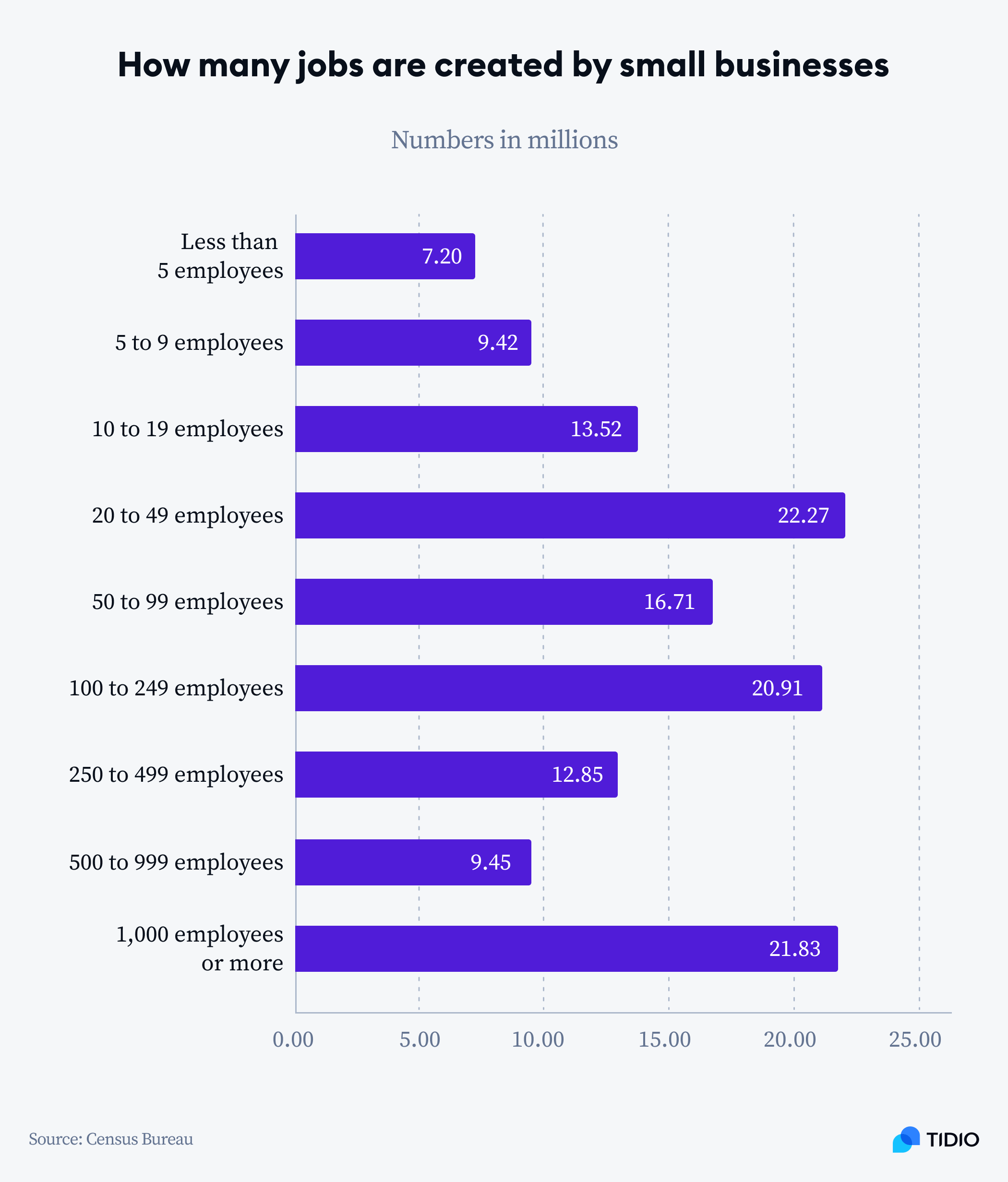
Companies with fewer than 500 employees generate more than 100 million jobs. In fact, small businesses have created more than 65% of new jobs in the economy since 2000. In the last two decades, small companies were responsible for 10.5 million net new jobs, while large companies created only 5.6 million.
Sounds impressive—
But how does that actually translate into revenue and GDP? How much do small business owners make?
4. An average small business owner makes about $60,000 per year
According to reports from Small Business Administration Council, small businesses contribute about 44% of the US GDP.
But while they are important to the economy, the majority of small business owners are not rolling in dough. In fact, many business owners struggle to make ends meet. The average revenue of a small business is about $60K per year according to Payscale.
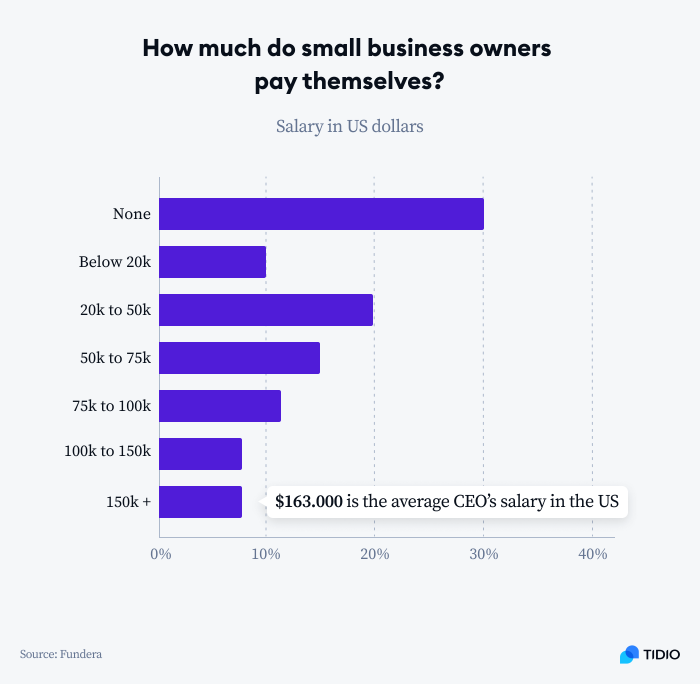
It’s important to note that this is an average revenue that includes the self-employed. The number is actually higher for businesses that have employees. However, 83% of small business owners earn less than $100,000. And there is also a significant number of those who make less than $50,000.
On top of that, many small business owners don’t pay themselves a salary at all in the early years! They frequently burn through their savings just to get through and get their business off the ground.
In fact, taking your business from startup to profitability is a major challenge for most small businesses. Only a fraction of businesses are profitable in their first years.
So—
What percentage of small businesses make a profit and how many of them fail?
5. Approximately 45% of small businesses fail during the first five years
There is a common belief that the majority of small businesses fail within a year. But that’s actually not true. According to the data from the US Bureau of Labor Statistics (BLS), the number is closer to 20%. However, the survival rate decreases significantly over time.
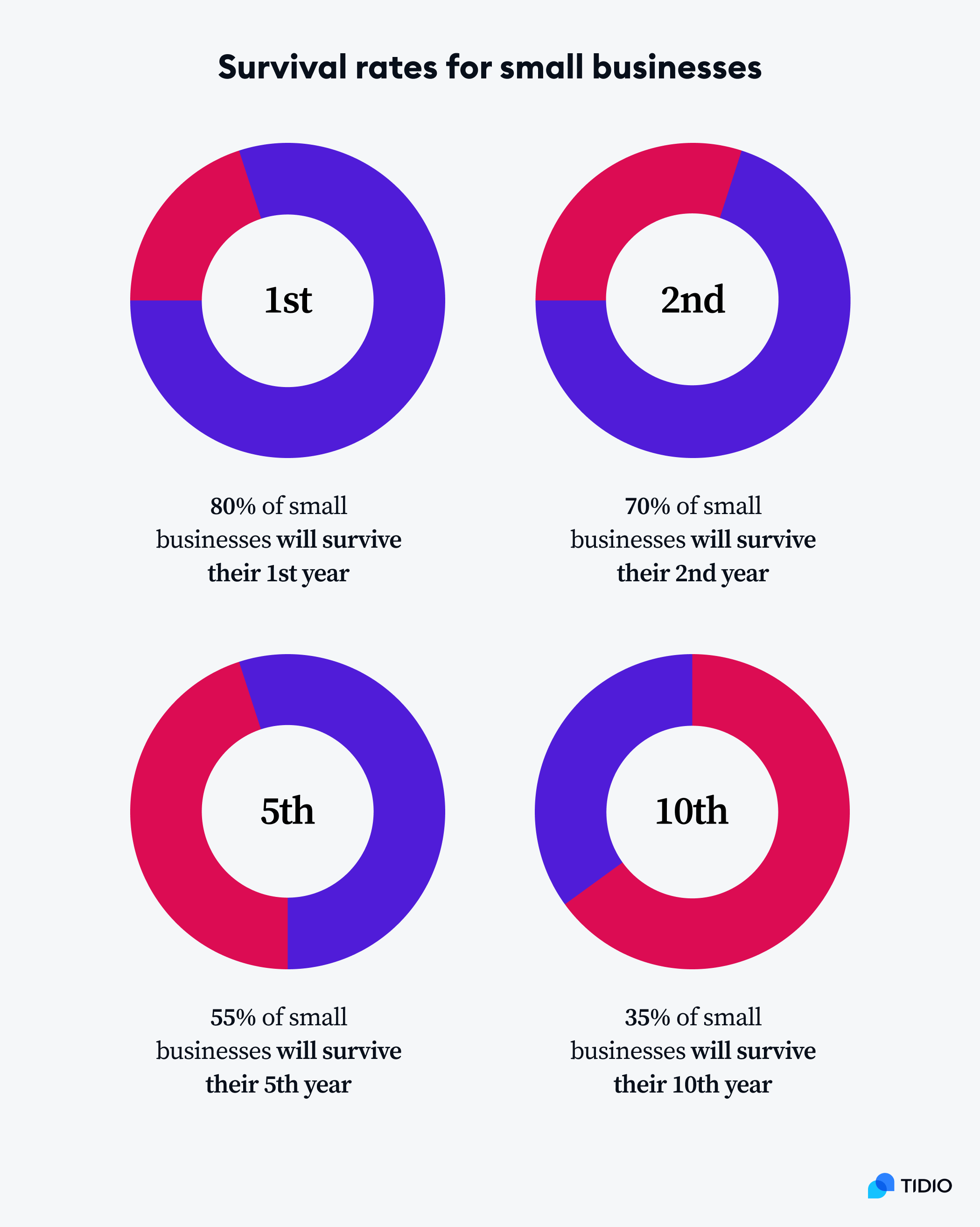
By the five-year mark, approximately 45% of small businesses are closed down. By the 10-year mark, it’s about 65%, and only about one-third of businesses are still in operation.
So—
What are the main reasons why small businesses fail?
The most common reasons for business failure are lack of capital, poor management, and not having a niche market. Companies that don’t pay enough attention to their online presence and advertising also have a higher failure rate.
6. The majority of small businesses allocate less than 2% of their budget to marketing efforts
On average, small businesses allocate only about 1% of their budget to marketing. When it comes to advertising, a good rule of thumb is to spend about 7% of your gross revenue on ads. But most new business owners spend only a fraction of that. According to SBA, an average small business allocates only about 1.08% of its annual budget to marketing.

This is a huge mistake because effective marketing is essential for any business to succeed. New companies need to let people know about their products or services in order to generate sales. And in today’s world, that means having an online presence and using a variety of digital marketing apps, such as Instagram bots. But, there are still many small businesses that don’t even have a website.
Read more: How to Prepare a Successful Product Marketing Strategy
7. Around 71% of small businesses have a website
The number has increased in recent years. In 2018, only about 50% of small businesses in the US had their own website. Now it’s 71% for the US and 75% for EU countries. The general trend is upward, and we can see that the number of small businesses with websites has been increasing steadily.
There is a big correlation between the size of the company and whether they have a website. Businesses with more employees are much more likely to build an online presence than businesses with fewer employees. This is probably because they have more resources to invest in web development and website management.
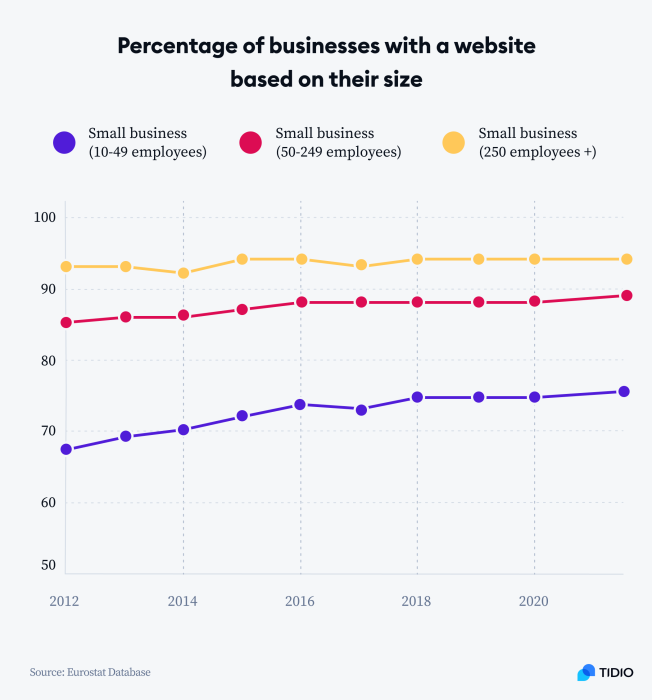
According to a report by Top Design Firms, there is still a significant number (28% to be precise) of small businesses that don’t have an online presence. This is a missed opportunity because having a website is one of the most effective marketing tools available. It allows you to reach a larger audience and show them what your company offers.
While having a website is absolutely necessary for businesses in the modern age, implementing it poorly can result in a lot of wasted time and money. If you cut corners in the design or development process, you’ll end up with a website that doesn’t inspire trust and may even get hacked!
In fact, cybersecurity is a notoriously neglected aspect when it comes to small businesses. This is why it’s important to scan your website for cybersecurity risks on a regular basis and act upon the data you get. And all it takes is one weak link in your website’s security to result in a devastating data breach.
Read more: How Are the Security Matters Handled at Tidio?
8. About 43% of all cybersecurity attacks target small businesses
Small businesses have been increasingly targeted by cyber-attacks in recent years, due to their lack of investment in cybersecurity and cyber resilience measures. In 2021, this has resulted in a 152% increase in data breaches among small businesses globally. That’s double the rate of increase among larger companies. As a way to combat this, many businesses are turning to threat management software, which helps identify potential security risks within the organization.

Cyberattacks can have devastating consequences for small businesses, which often lack the resources to quickly recover from such an event. In addition to the direct financial costs, a data breach can also lead to reputational damage and loss of customer trust.
However, there are many other concerns that small businesses have to face today.
9. In the US, COVID-19 had a negative impact on 66% of small businesses
The pandemic has been a major blow to small businesses around the world. In the US, two-thirds of small businesses reported negative impacts from COVID-19, such as reduced revenue or temporary closure.
The overall level of fear among entrepreneurs has begun to decline. Nonetheless, there are still many companies that struggle with reduced demand, supply chain disruptions, and cash flow problems.
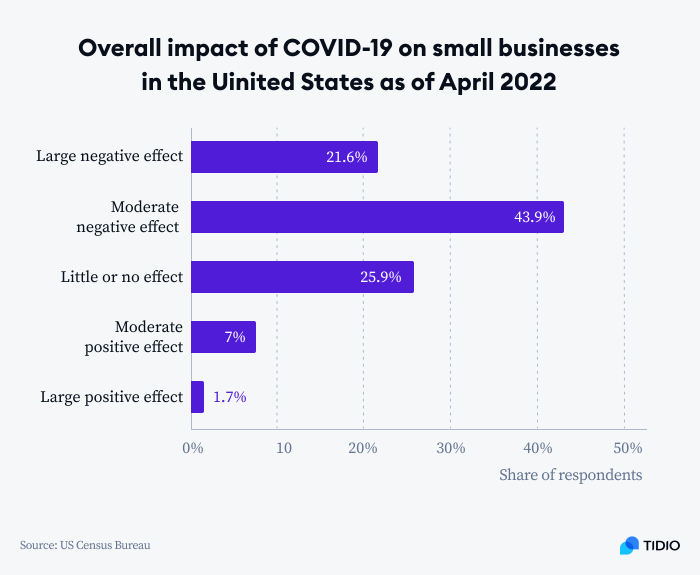
In addition to the pandemic, small businesses also have to deal with other challenges such as inflation and the rising cost of labor.
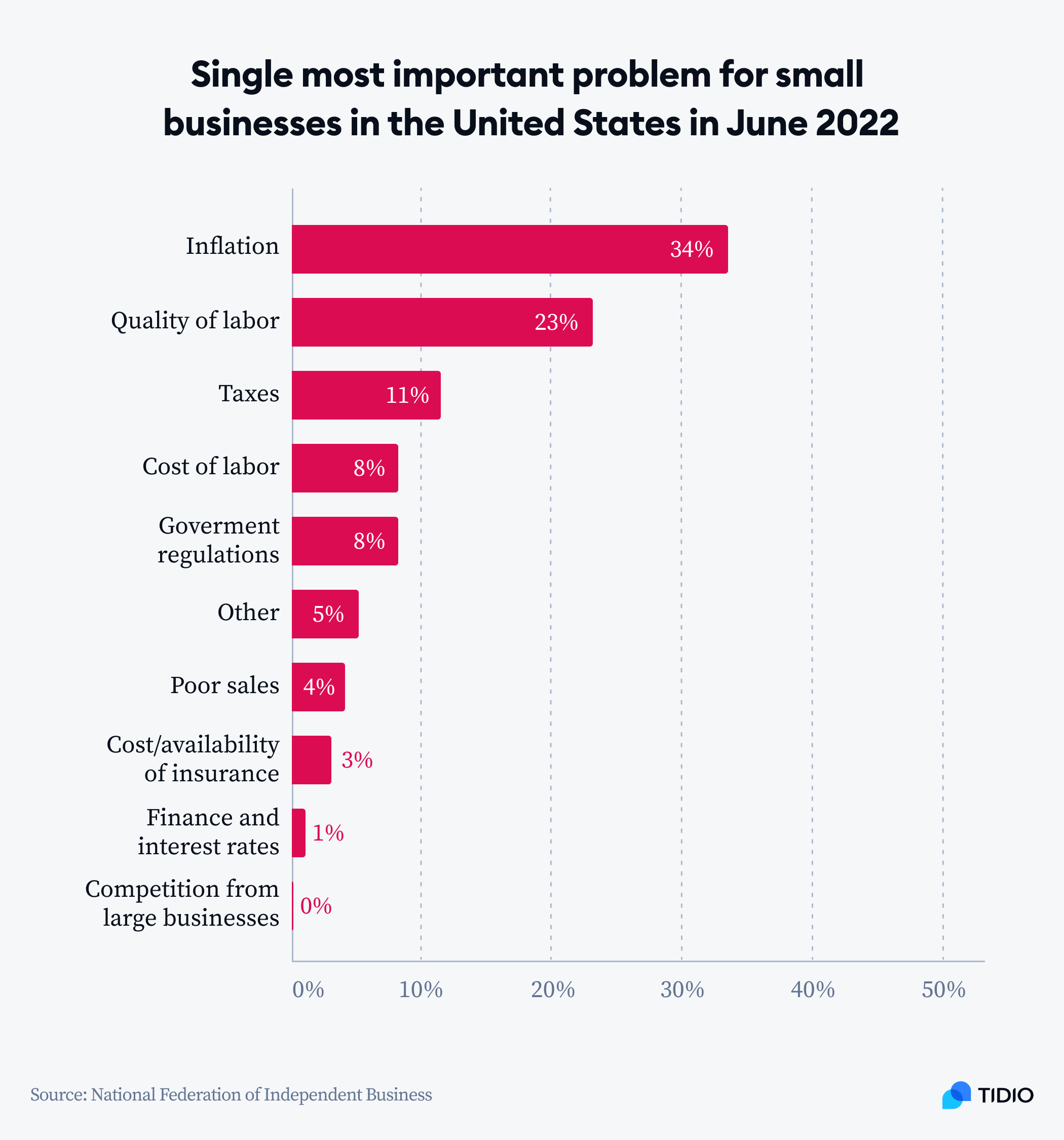
Inflation, declining quality of labor, and rising costs are major concerns for businesses of all sizes, but it hits small businesses particularly hard. It’s their biggest challenge because they often don’t have the same economies of scale as larger businesses. As a result, they are less able to absorb increases in high-quality labor costs.
The pandemic and the current economic environment have also forced many businesses to change the way they operate.
For example, many retailers have had to shift to online sales in order to stay afloat. This has been a major challenge for businesses that were not prepared for it. On the other hand, this turned online retail into the most dynamically growing industry for small businesses.
Case study: See how Bella Sante, a med SPA, increased their revenue with the help of conversational chatbots.
10. Over 15% of all small businesses operate in retail and online sales
Retail is the most popular type of small business in the US. In recent years, online retail in particular has grown dramatically. This is connected to the emergence of popular ecommerce solutions such as Shopify or BigCommerce. They made it easier for businesses to set up an online presence and automate customer service and sales with CRM software. According to online shopping statistics, ecommerce sales are going to double before the end of the decade (such as Tidio or Salesforce).

The growth of ecommerce has been driven by other factors too, including the increasing use of mobile devices and the popularity of social media marketing. As a result, we expect that the trend of moving towards online retail will continue in the coming years.
Read more: Check out the latest ecommerce statistics and trends as well as social commerce statistics.
We can see which businesses are the most common by looking at the absolute number of SME companies in a given industry. However, it doesn’t really show if some niches grow faster than others. The table below gives us more insights into the fastest-growing small businesses in the US by industry.
| Industry | Relative year-over-year growth for small businesses* |
|---|---|
| Warehouses, Storage Units, and Non-residential Buildings | 80.73% |
| Gas Stations | 57.68% |
| Beer, Wine, and Liquor Stores | 50.53% |
| Hospitality Industry (Hotels and Motels) | 47.12% |
| Automotive, Repair, and Maintenance | 29.27% |
| Insurance Agencies and Brokerages | 23.00% |
| Landscaping Industry | 20.74% |
| The Freight Trucking Industry | 19.28% |
| Janitorial Service Industry | 14.19% |
| Restaurant and Food Service Industry | 13.65% |
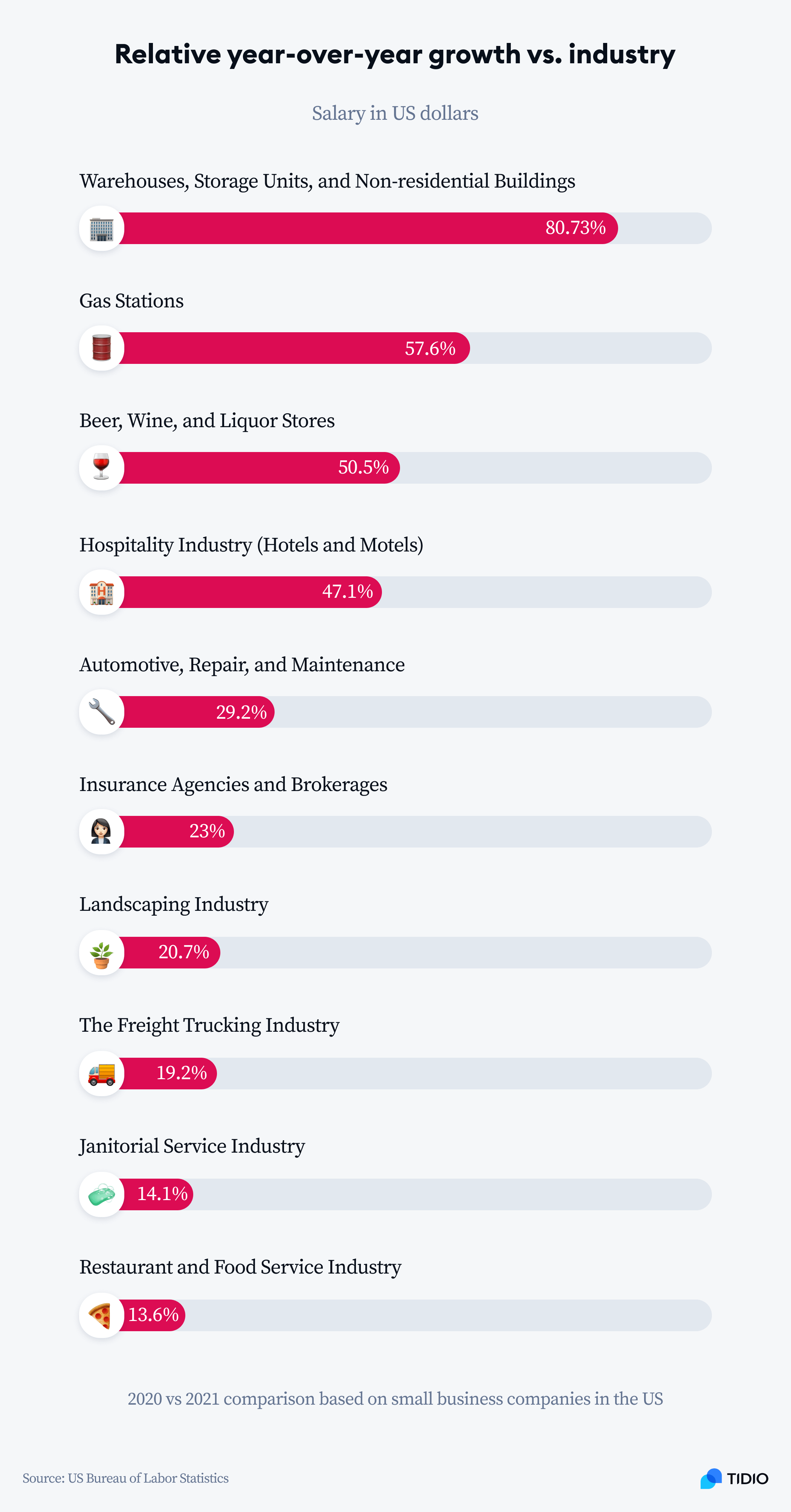
Many of the businesses, such as hospitality and automotive have been hit very hard by the pandemic. But they are starting to rebound as the economy begins to reopen.
On the other hand, some of the businesses on this list, such as freight trucking, have been growing steadily even during the pandemic. That’s likely due to the continued growth of online retail and the need for businesses to ship goods quickly and efficiently.
Read more: How to Set Up and Run a Successful Shopware Business
11. There were over 5 million new business applications this year alone
The growth rate of the small business sector is impressive. In the US, about 5.4 million new business applications were filed in 2021. This is a 23% increase from 2020. It’s worth noting that many people have lost their jobs due to the pandemic and have decided to start their own businesses and form their own LLC.

There are many reasons why people decide to start their own small firms. Almost 61% claim that they are disappointed with so-called “Corporate America.” They feel that the traditional job market doesn’t offer the same stability and opportunities that it used to.

Others, almost 48%, start their own business because they feel ready to be their own boss. They want the freedom to make their own decisions and be in control of their own destiny. This is a significant motivation for many people, especially those who are dissatisfied with their current jobs.
So—
What are some small business trends when it comes to the demographical perspective?
12. Business owners who are over 40 years old own 63% of small businesses in America
The majority of small business owners in the US are in the 40+ age group. This is likely due to the fact that starting a business takes time, money, and experience. It’s not something that most people can do overnight.
This doesn’t mean that young people can’t be good entrepreneurs. In fact, some of the most successful businesses have been started by Millennials and young people. However, it does take a certain level of maturity and experience.
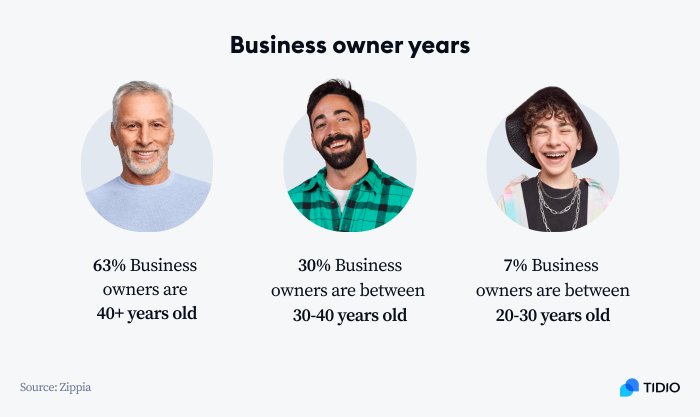
Interestingly, in recent years the gender gap among business owners has been narrowing. In the past, most small businesses were owned by men. Right now, however, almost 49% of small enterprises are women-owned businesses.
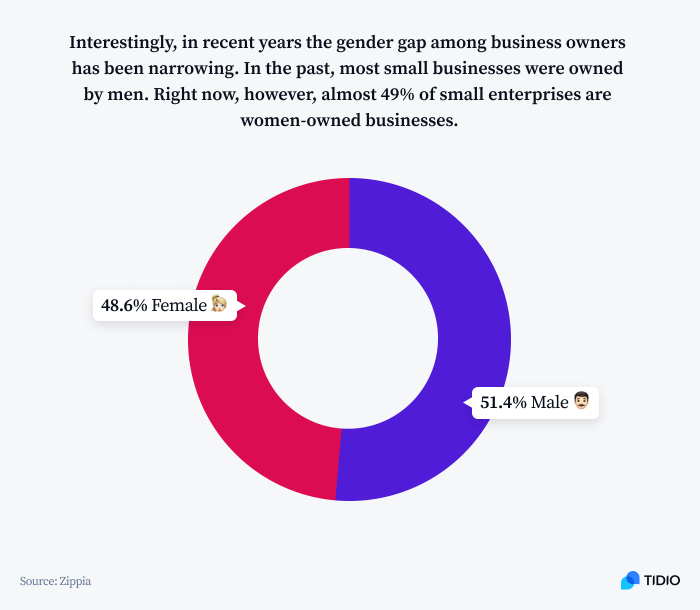
The number of business owners representing minorities is also on the rise. Right now, over 14% of small companies are owned by Hispanics and Latinos, and about 6% are owned by Asians. A marginally smaller number of businesses is owned by African Americans.

There are still some significant differences when it comes to revenue, but minority-owned businesses are growing at a faster rate than ever before. In fact, Asian business owners have the highest average salaries at $75,000 (compared to $70,000 earned by White business owners).
Key takeaway
Hopefully, the selection of small business statistics above provides some valuable insights into the current state of the small business sector in America.
As you can see, despite the challenges posed by the pandemic, small businesses are still managing to grow and thrive.
First of all, the small business sector is booming, with over 5 million new businesses being started in 2021.
Secondly, there are many reasons why people decide to start their own small firms, but the most common reason is disillusionment with Corporate America.
Last but not least, the majority of small business owners are Gen X and Baby Boomers, but the number of young entrepreneurs is on the rise too. Women and minority business owners are also becoming more successful than ever before.
There are many opportunities for those who are thinking about starting their own business. And with the right planning and execution, your small business can be a big success.
Sources:
- How Many Jobs Do Small Businesses Really Create?
- Top 6 Reasons New Businesses Fail
- Online Presence Management Tips for Small Businesses
- Eurostat Data Explorer: Business Websites & Functionalities
- Weak Cybersecurity Is Taking a Toll on Small Businesses
- Cybersecurity Statistics Small Businesses Should Know
- What Industries Are Small Businesses In?
- Top 10 Small Business Industries to Start in 2022
- Small Business Owner Demographics and Statistics in the US
- Small Business Facts: Business Ownership Demographics

